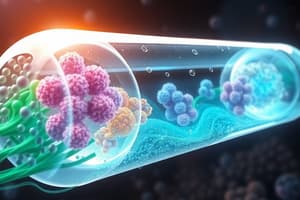Podcast
Questions and Answers
What occurs to a cell placed in a hypertonic solution?
What occurs to a cell placed in a hypertonic solution?
- The cell swells and bursts.
- The cell maintains its size.
- The cell shrinks due to water moving out. (correct)
- Water moves into the cell.
What is the main characteristic of an isotonic solution?
What is the main characteristic of an isotonic solution?
- Lower concentration of water compared to the cell.
- Leaves the cell in a state of plasmolysis.
- Higher concentration of solutes inside the cell.
- The concentration of solutes is equal inside and outside the cell. (correct)
How do bacteria and plants cope with osmotic pressure?
How do bacteria and plants cope with osmotic pressure?
- They use specialized gills to expel excess salt.
- They excrete excess water through contractile vacuoles.
- They absorb water through their membranes at all times.
- They have cell walls that reduce expansion. (correct)
What mechanism do saltwater fish use to maintain osmotic balance?
What mechanism do saltwater fish use to maintain osmotic balance?
What is turgor pressure in plants?
What is turgor pressure in plants?
What is one of the primary functions of the cell membrane?
What is one of the primary functions of the cell membrane?
What characteristic of phospholipids in the cell membrane makes it selectively permeable?
What characteristic of phospholipids in the cell membrane makes it selectively permeable?
Which of the following transport processes does not require energy?
Which of the following transport processes does not require energy?
Which statement accurately describes the lipid bilayer of the cell membrane?
Which statement accurately describes the lipid bilayer of the cell membrane?
In the context of cellular transport, what is osmosis?
In the context of cellular transport, what is osmosis?
Which component of the cell membrane serves as markers for cell recognition?
Which component of the cell membrane serves as markers for cell recognition?
What term is used to describe the model that explains the structure of the cell membrane?
What term is used to describe the model that explains the structure of the cell membrane?
What occurs during active transport?
What occurs during active transport?
What is the primary characteristic of facilitated diffusion?
What is the primary characteristic of facilitated diffusion?
Which process describes the movement of water across a selectively permeable membrane?
Which process describes the movement of water across a selectively permeable membrane?
What is the outcome of a hypotonic solution on a cell?
What is the outcome of a hypotonic solution on a cell?
In what direction do sodium ions move during the operation of the sodium-potassium pump?
In what direction do sodium ions move during the operation of the sodium-potassium pump?
What is one primary distinction between passive and active transport?
What is one primary distinction between passive and active transport?
Which type of active transport involves the cell membrane in-folding around food particles?
Which type of active transport involves the cell membrane in-folding around food particles?
What would likely happen to a cell placed in a hypertonic solution?
What would likely happen to a cell placed in a hypertonic solution?
Which type of molecules are typically transported by ion channels?
Which type of molecules are typically transported by ion channels?
Which pump is vital for nerve impulse transmission?
Which pump is vital for nerve impulse transmission?
What happens during exocytosis?
What happens during exocytosis?
Which statement best describes diffusion?
Which statement best describes diffusion?
What role do carrier proteins play in facilitated diffusion?
What role do carrier proteins play in facilitated diffusion?
Which type of solution has a higher solute concentration relative to the cell's interior?
Which type of solution has a higher solute concentration relative to the cell's interior?
What type of diffusion specifically involves the movement of water?
What type of diffusion specifically involves the movement of water?
Flashcards
Hypertonic Solution
Hypertonic Solution
A solution with a higher solute concentration and lower water concentration than the cell.
Isotonic Solution
Isotonic Solution
A solution with an equal solute concentration to the cell.
Hypotonic Solution
Hypotonic Solution
A solution with a lower solute concentration and higher water concentration than the cell.
Osmosis
Osmosis
Signup and view all the flashcards
Cell Wall's Role in Osmosis
Cell Wall's Role in Osmosis
Signup and view all the flashcards
Cell Membrane Function
Cell Membrane Function
Signup and view all the flashcards
Lipid Bilayer
Lipid Bilayer
Signup and view all the flashcards
Selectively Permeable
Selectively Permeable
Signup and view all the flashcards
Passive Transport
Passive Transport
Signup and view all the flashcards
Diffusion
Diffusion
Signup and view all the flashcards
Active Transport
Active Transport
Signup and view all the flashcards
Protein Pumps
Protein Pumps
Signup and view all the flashcards
Homeostasis
Homeostasis
Signup and view all the flashcards
Facilitated Diffusion
Facilitated Diffusion
Signup and view all the flashcards
Sodium-Potassium Pump
Sodium-Potassium Pump
Signup and view all the flashcards
Endocytosis
Endocytosis
Signup and view all the flashcards
Exocytosis
Exocytosis
Signup and view all the flashcards
Equilibrium
Equilibrium
Signup and view all the flashcards
Ion Channels
Ion Channels
Signup and view all the flashcards
Carrier Proteins
Carrier Proteins
Signup and view all the flashcards
Selectively Permeable Membrane
Selectively Permeable Membrane
Signup and view all the flashcards
Low Concentration
Low Concentration
Signup and view all the flashcards
High Concentration
High Concentration
Signup and view all the flashcards
Study Notes
Cell Membranes
- All cells possess a cell membrane.
- Functions include controlling what enters and exits the cell, maintaining homeostasis, and providing protection and support.
Structure of the Cell Membrane
- Composed of a lipid bilayer (two layers of phospholipids).
- Phospholipids have polar phosphate heads (water-loving) and non-polar fatty acid tails (water-fearing).
- Proteins are embedded within the membrane.
- Carbohydrate cell markers are present.
- The fluid mosaic model describes the membrane's structure.
Cell Membrane Permeability
- The membrane is selectively permeable, allowing some molecules to pass and blocking others.
- Pores (holes) in the membrane contribute to its selectivity.
Cellular Transport
Passive Transport
- Requires no energy input from the cell.
- Molecules move from high concentration to low concentration.
- Diffusion: random movement of particles from high to low concentration until equilibrium is reached.
- Facilitated Diffusion: diffusion aided by transport proteins, specifically designed proteins for particular molecules.
- Osmosis: diffusion of water across a selectively permeable membrane.
Active Transport
- Requires energy input from the cell.
- Molecules move against their concentration gradient (low to high).
- Protein Pumps: transport proteins that use energy to move molecules. An example is the Sodium-Potassium pump which has an important role in nerve responses.
- Endocytosis: taking bulky materials into the cell. The cell membrane folds around the material, forming a vacuole, which is then used to digest the substances.
- Exocytosis: forcing materials out of the cell.
Sodium-Potassium Pump
- A vital active transport protein.
- Moves three sodium ions out of the cell and two potassium ions into the cell per cycle, against their concentration gradients. This action helps transmit nerve impulses.
- The pump changes shape during the process, using energy from ATP breakdown.
Osmosis and Solutions
- Hypotonic Solution: Water moves into the cell, causing the cell to swell and possibly burst (cytolysis).
- Hypertonic Solution: Water moves out of the cell, causing the cell to shrink (plasmolysis).
- Isotonic Solution: Equal water movement in and out of the cell, maintaining cell size.
How Organisms Deal with Osmotic Pressure
- Cell walls prevent overexpansion in plants and bacteria.
- Contractile vacuoles aid protists in water regulation.
- Some organisms, like saltwater fish, actively regulate internal salt concentration and water balance.
- Animal kidneys maintain blood isotonicity.
Studying That Suits You
Use AI to generate personalized quizzes and flashcards to suit your learning preferences.




